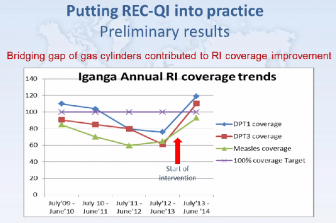
Nov 18, 2014
BLN Webinar: RED-QI (Reaching Every District incorporating Quality Improvement)
EPI Plan, Human Resources Plan, Monitoring & Evaluation, Tools
Ethiopia, Uganda
The Better Immunization Data Learning Network (BLN) recently hosted a webinar which elaborated on RED-QI (Reaching Every District incorporating Quality Improvement approaches). The “RED-QI” approach is a process that supports addressing larger priority problems (e.g. persistently high drop-out rates) using small, rapid, doable changes that can be quickly tested and evaluated for adoption, adaption, or abandonment at the local level.
Oct 10, 2014
Toolkit: Bridging the Gap between Ministries of Health and Ministries of Finance
In many countries, Ministries of Health (MOHs) and Ministries of Finance (MOFs) determine which health services are delivered, when, where, and for whom. MOHs are responsible for setting national health policy and managing the day-to-day delivery of public health services, but they are dependent upon MOFs for establishing funding levels and releasing the necessary funds to finance MOH operations. Designed for health sector managers, the new Toolkit for Ministries of Health to Work More Effectively With Ministries of Finance, presents four different tools to help MOH staff better manage their resources and communicate more effectively with their MOF counterparts.Oct 1, 2014
mHealth Mobile Messaging Toolkit
This toolkit provides information about currently available mobile messaging technology solutions, as well as things to consider when selecting a vendor and deploying a mobile health, or mHealth, campaign. It is meant to be used with other resources on project design, content developement, and behavioral change communications, including Planning an Information System Project: A Toolkit for Public Health Managers.Aug 1, 2014
Understanding the needs and wants of Community Healthcare Workers
mHealth, Peer Learning, Software, Telecommunications, Tools, Training
South Africa
This work builds on the recently published End Consumer Primary Research and aims to inform health and mobile stakeholders about the users of mHealth services in the public sector. The GSMA expects this market knowledge to lead to product design that is more aligned to the needs of users (consumers and health workers), greater adoption and achievement of economies of scale and sustainability, and robust partnershipsbetween public and private sector stakeholders that ultimately reduce the widespread fragmentation of mHealth services in South Africa.
Aug 28, 2014
Product Vision for the Better Immunization Data (BID) Initiative
Applications, DHIS2, eHealth, eHealth architecture, eLMIS, Hardware, iHRIS, Immunization Registry, mHealth, openMRS, Products, SMT (Stock Management Tool), Software, Standards, Supply Chain, Tools
Global
The Product Vision for the Better Immunization Data (BID) Initiative combines a "top down" approach with a "bottom up" view. We begin with the national strategies, incorporating the current context of the users (e.g., the functional architecture) before considering the facility applications (e.g., the technical architecture) that are in use and have gained traction, and how they might tie together. Through a series of seven chapters, you will be led through the steps to organize how your processes and information and communication technology (ICT) infrastructure can be integrated and standardized to meet a ministry of health's vision and requirements. This document is not intended to be a definitive description of any single country's health enterprise architecture (EA). Rather, it is a starting point; a toolkit that may be adapted by countries, as necessary, to a specific country's needs and reflective of their unique context. Readers are not expected to be experts in ICT or in EA. However, a basic knowledge of eHealth and its role in supporting health care delivery workflows is assumed. The document is written in plain language with background information, illustrations of key points, and examples where it is thought they will be helpful.
Jan 22, 2008
Understanding Biometrics
Applications, eHealth, eHealth architecture, Hardware, Standards, Tools
Global
Biometrics refers to the automatic identification of human beings based on their physical and/or behavioural characteristics (Bio = life + Metrics = measurement). These characteristics present some specific properties such as, uniqueness and persistency, making them suitable for this kind of task. Examples of physical characteristics include among others: fingerprints, face, iris, retina, and hand geometry. On the other hand, examples of behavioural characteristics include: signature, voice, keystroke dynamics, etc. The purpose of this book is to serve as an introductory source of information for people interested in Biometrics.
Jul 14, 2014
Understanding the needs and wants of pregnant women and mothers
Maternal, perinatal and under-5 mortality in South Africa remain high. It is estimated that 40% of all deaths are avoidable. With the ubiquity of mobile services in developing markets, value-added services such as mobile money and mobile health (mHealth) are increasingly offered as a more convenient and cheaper solution for people to access not only information but also actual financial and healthcare services.Jan 8, 2007
Using a Fingerprint Recognition System in a Vaccine Trial to Avoid Misclassification
Applications, eHealth, eHealth architecture, Immunization Registry, Peer Learning, Tools
Global
May 1, 2014
Project Mwana: Using mobile technology to improve early infant diagnosis of HIV
eHealth, mHealth, openMRS, Software, Telecommunications, Tools, Unicef
Zambia
Aug 1, 2012
Improving Data Use in Decision Making: An Intervention to Strengthen Health Systems
Policies, Practices, PRISM (Performance of Routine Information System Management), Regulation, Standards, Supportive Supervision, Tools, Training, USAID
Global
Jump in. Expand your knowledge.
Events
No upcoming events.
